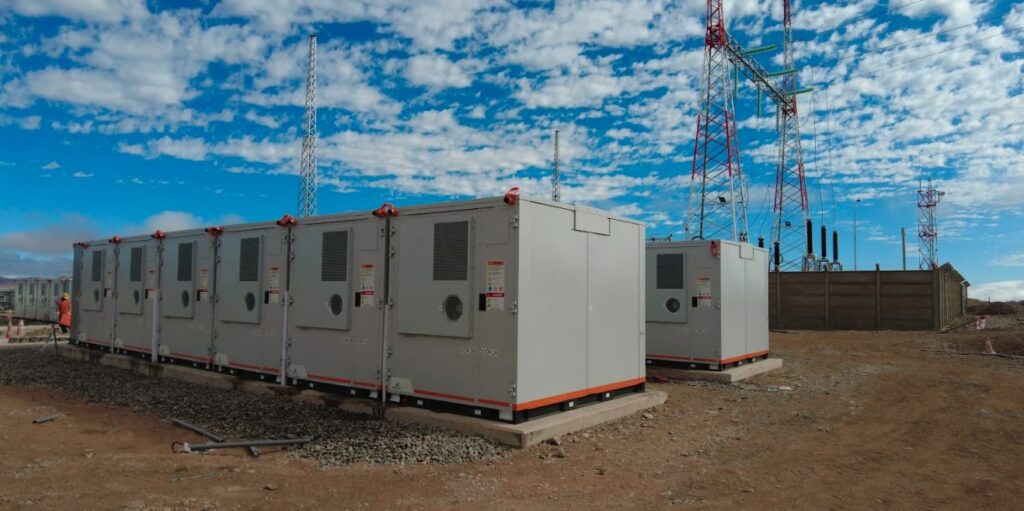In March, the energy storage system integration, manufacturing and solutions arm of the Finnish marine and energy technology company announced its grid-scale battery energy storage system (BESS) product, GridSolv Quantum, had completed testing under UL9540A.
At the time, a representative of Fire & Risk Alliance, a third-party expert group overseeing the thermal runaway propagation testing, said the integrated modular solution, equipped with CATL lithium iron phosphate (LFP) cells, had achieved the “best possible outcome from the tests”.
Today, Wärtsilä announced that GridSolv Quantum has now been put through an even more thorough large-scale fire testing programme which not only exceeded the standards of UL9540A and other industry benchmark tests, but put the system into the sort of “worst-case-scenario” situations Furlong described.
Again, overseen by Fire & Risk Alliance with fellow experts Energy Safety Response Group (ESRG) and Energy Security Agency, testing was carried out at a facility in Ohio.
The company wanted to evaluate what would happen in the event of a catastrophic scenario – however unlikely that might be in real-world circumstances – intentionally lighting a fire inside a GridSolv Quantum containerised unit.
The fire was allowed to burn freely for eight hours inside the ventilated unit, and the test showed that doors would remain closed, preventing fire from spreading to any neighbouring enclosures. In addition, Fire & Risk Alliance captured the gases released by the fire and concluded they would be no more harmful than those from a burning normal consumer product.
“Our recent testing programme created the worst-case-scenario that has been tested in the industry to date. Specifically, our engineers allowed oxygen to flow into the battery enclosure to continuously feed the flame. Others have done similar testing, but nobody has allowed for this kind of ventilation – intentionally adding fuel to the fire,” Darrell Furlong said.
“Wärtsilä’s bespoke testing is the ideal way to demonstrate that a fire will not propagate between ESS enclosures or from string to string,” Fire & Risk Alliance MD Noah Ryder said.
“This outcome illustrates that with minimal or no response from the fire service or other responders, a fully involved fire is unlikely to spread beyond the initiating unit.”


Why it matters
Most industry standard tests are conducted at the component or sub-system level, rather than taking a whole-system approach as Wärtsilä has chosen to do, according to Darrell Furlong.
“We have found that doing this kind of bespoke, worst-case-scenario testing demonstrates to our stakeholders that we’re serious about safety. Our testing above and beyond single-cell heating represents a scenario where multiple cells go into thermal runaway after something like a lightning strike, coolant leak, or forklift incident,” Furlong told Energy-Storage.news.
Rather than just passing the minimum requirements, the company is “spending time and money” on a rigorous testing programme aimed at giving customers complete confidence in its technology, Furlong said.
While that means it can act as case study into what happens when the very worst does happen from a customer perspective, it would also provide peace of mind for fire crews and other responders, ensuring that: “…a full-scale flaming event would be contained to the initiating unit and would require only limited, defensive firefighting by first responders, should there be wind-driven flames or other environmental exposure risks,” Wärtsilä product development manager Chris Groves said.
The company said such data would assist the decision-making of authorities having jurisdiction (AHJ), which in the US often have the final definitive say on project permitting and approvals. Groves said the company also hoped the tests would set a new industry standard that others could follow.
In a recent Guest Blog for this site on the vital importance of fire safety, penned by Wärtsilä’s Darrell Furlong together with ESRG principal Nick Warner, the pair wrote that the energy storage industry is, understandably, having more and more contact with AHJs. There is a need to plug the knowledge and communications gap that often leaves AHJs feeling that they lack sufficient information about causes and implications of fires at storage systems.
“As the risks posed by energy storage systems are better understood by AHJs, the desire to incorporate even more data into the safety analysis requires greater scale and evolution in testing,” ESRG’s Nick Warner said about the bespoke testing regime.
“Test results such as those from large-scale fire tests help inform this process, which overall allows for better analysis and satisfaction of code requirements.”
Wärtsilä is certainly not alone among industry players to recognise the importance of announcing its fire testing results, even if it has a claim to being a first-mover into more stringent regimes. Rival Fluence got UL9540A testing completed for its large-scale lithium-ion BESS solution last September, Powin Energy completed it for its Stack products in November 2021, while CATL, having become a BESS manufacturer as well as cell manufacturer, recently got certification to conduct its own testing.
Various non-lithium storage technology providers have completed UL9540A and got other UL certifications including UL1973 in recent months too, including vanadium flow battery provider Invinity Energy Systems and metal-hydrogen battery startup Enervenue. Yesterday ESS Tech Inc (ESS Inc), which makes a proprietary iron electrolyte flow battery, said that it too has completed UL9540A tests for its Energy Warehouse product.
In a recent Energy-Storage.news webinar, sponsored by IHI Terrasun, experts from groups including DNV discussed UL9540A codes and standards.

